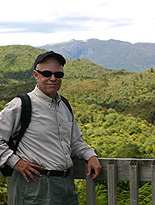|
 Roger del Moral Roger del Moral
Professor of Biology
Dr. del Moral received his doctorate with C. H. Muller at the University of
California, Santa Barbara, in 1968. He immediately joined the Botany
Department at the University of Washington. Here he began a series of
studies of vegetation patterns in forests and alpine sites. In 1976-1977,
he spent a year in Australia at the CSIRO in Queensland and at Melbourne
University. Along with David Ashton, he was the first to demonstrate that Eucalyptus
inhibited native Australian shrubs in nature. His pioneering work on plant
competition in stable alpine habitats was interrupted by the 1980 eruption
of Mount St. Helens. He was among the first ecologists to begin study of
the recovery of this volcano, studies which have produced one of the
longest continuous records of primary succession now extant. In 1984, he
worked on reclamation of derelict sites in the U.K. (with A. D. Bradshaw,
A. Fitter and M. Chadwick), while in 1985 he was introduced to a wide
variety of Japanese volcanoes (S. Kawano, H. Tagawa, M. Numata, M. Shizuoka).
He has explored volcanoes in the Russian Far East with Sergei Grishin), in
Sicily with Prof. Emilia Poli Marchese (during his Sabbatical), in Iceland
(Hekla and Surtsey) with Dr. Borgthor Magnusson and in New Zealand with
Professor Bruce Clarkson. In 2007, he published Environmental
disasters, natural recovery and human responses, a general book on restoring the landscape using
the lessons gained from nature.
Research Interests
Dr. del Moral has studied and described vegetation structure in forests,
prairies, wetlands and meadows throughout Washington. His approach is
deductive, rather than purely inductive, in that his projects test a
priori hypotheses rather than merely describing communities. He has
studied factors that control community structure in stable communities, but
since 1980, his work has centered on primary succession and its
relationship to restoration. Most of this work has explored the mechanisms
of vegetation recovery on Mount St. Helens, but he has conducted research
on several other volcanoes. A
series of papers have combined long-term plot records, focused field
experiments and laboratory trials to explore mechanisms of primary
succession. Several bits of "conventional wisdom" have been
modified or shown to be overly simple. Stochastic processes are very
important during early succession and landscape effects, more than any
other factor, dictate the nature of early species assemblages. In contrast
to prevailing theory, abiotic amelioration is much more important that
biotic facilitation, physical safe-sites are initially more important than
nurse plant effects, refugia contribute little to the development of their
surroundings, and mycorrhizae play a very limited role on volcanic
succession. His studies in Japan and the Russian Far East have shown that
similar processes have controlled succession on volcanoes in these regions.
In Sicily, working on Mount Etna, he has found that there has been little
vegetation convergence on lavas during eight centuries. In 2005, the 50th
paper from his lab concerning primary succession was published. With Lars Walker of UNLV, he
completed a book on the current concepts of primary succession that
summarizes the historical and developing concepts surrounding how
landscapes are recolonized after devastating disturbances. Widely
recognized as a major synthesis of the state of knowledge in primary
succession, the book has won praise from ecologists
and restorationists alike.
In 2007, he published a book on ecological responses to natural disasters
intended for a more general public. He and Lawrence Walker hopes that this book stimulates a wider knowledge of ecological principles in the service of great quality of life.
His doctoral students have also worked on a many projects. Rex Cates
performed ground-breaking studies in plant-animal chemical interactions.
Ted Hinds produced detailed energy budgets for cheat grass communities. The
late Joy Belsky quantified environmental gradients in subalpine meadows,
while Martha Cushman developed predictive models to relate vegetation
structure to avalanche frequency. Virginia H. Dale modeled bumblebee
foraging behavior in alpine habitats of Mount Rainier, while David Wood
demonstrated that successional sequences were based on contingent factors.
C. L. Huang showed how competition altered expected successional pathways.
More recently, Jon Titus developed elegant experiments that demonstrated
that primary succession on Mount St. Helens did NOT require mycorrhizae,
while Dennis Riege demonstrated that old-field succession in the Olympic
Rainforest was controlled largely by competition from introduced herbs.
Chad Jones completed his study of invasions of glacier forelands in the
North Cascades and Tara Fletcher Ramsey recently finished a though study of
the mechanisms by which ivy invades natural vegetation. Current students are investigating several aspects of succession
on Mount St. Helens.
|